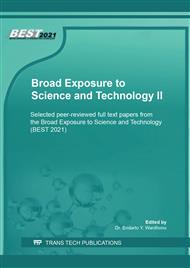p.167
p.176
p.189
p.197
p.205
p.211
p.218
p.227
p.235
Effect of Phase Transformation on Surface Roughening Behavior in Austenitic Thin Metal Foils
Abstract:
Stainless steels have wide application in the field of micro manufacturing industry. The size effect occur in thin metal foils because of low number of grain. Martensitic phase transformation (MPT) occur after plastic deformation subjected to stainless steel thin metal foils. Beside that, free surface roughening occur in thin metal foils after plastic deformation. The surface roughening mechanism in stainless steel thin metal foils after plastic deformation such as uniaxial tensile test not yet clarified well. MPT and grain misorientation (GMO) have huge effect to surface roughening behavior in stainless steel thin metal foils. The effect of GMO and MPT to surface roughening in SUS 316 and 304 thin metal foils were studied through uniaxial tensile stress state, repeated five times in 6% strain level for one time strain and 30% strain for the total of strain level. After that, an Scanning Electron Microcope-Electron Backscatter Diffraction (SEM-EBSD) analysis applied to 304 and 316 thin metal foils. The result showed that in stainless steel thin metal foil, surface roughening increase proportional both in fine gain (grain size 1,5 μm) and in coarse grain (grain size 9,0μm). The surface roughening in coarse grain, increased higher than in fine grain. The grain strength in SUS 304 is more inhomogeneous compared to SUS 316 that shown by SEM-EBSD results and as a result, increasing ratio of the surface roughness (Ra) is higher in fine grain and coarse grain of SUS 304 compared to SUS 316. The inhomogeneity of the grain strength in SUS 304 thin metal foil is higher than SUS 316 thin metal foil as shown by SEM-EBSD result. Furthermore, the increased surface roughness in stainless steel 304 is higher than stainless steel 316 thin metal foil both in fine grain and coarse grain. Key words : Surface roughening, Martensitic phase transformation (MPT), Grain Misorientation.
Info:
Periodical:
Pages:
205-210
Citation:
Online since:
March 2022
Authors:
Price:
Сopyright:
© 2022 Trans Tech Publications Ltd. All Rights Reserved
Share:
Citation:


